A male to female Transgender. She has bitemporal receding from androgenic alopecia, which is not very desirable. She seeks some kind of camouflage, after female hormone, Minoxidil and Finasteride particular hairstyle, hairpieces, etc. Her last resource is Hair Transplant to cure her baldness. FUE from the occipital scalp (927FU) and pubic (405FU) area then transplant to the bald spot is the final solution. 1,332FU was done. Hairline construction follows the “Line Thai Micro Hairline principle.” Nine months later, she comes back with a very soft, smooth heart shape feminine hairline.
Keywords
Hair transplant, Female transgender, Hair style, Hormone pills
A male to female Transgender with bitemporal recession. She is looking for a Hair Transplant to the bald area. She takes hormone pills for almost 20 years. She is in very good health status. After History is taken and physical exam. Diagnosis of mild bitemporal baldness from genetic androgenic alopecia was made. The blood test also shows that she is in good physical condition no contraindication for surgery. Bleeding time coagulation time is within the normal limit. The area of baldness is about 2x3cms each.
After a detailed explanation and discussion, she agrees to upon F.U.E. (Follicular Unit extraction) pubic and scalp hair transplant to the bald area. Pubic hair because can save her scalp hair and increase the volume of new hair. She satisfies with the total design of her new hairline. She has a lovely widow's peak so let's keep it that way. Hair pattern and density etc. (Figure 1).
I will use the LINE THAI MICRO HAIRLINE principle for this construction. Details will follow in the discussion. She signed consent for surgery. Before surgery photo is taken (Photo 1, before surgery), Then she goes to have her hair washed with strong antiseptic shampoo. After drying her hair, she comes back to the consultation room to have her hairline draw and mark again. (Figure 1) Then go to the operating room.
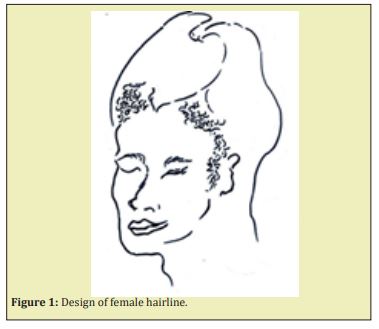
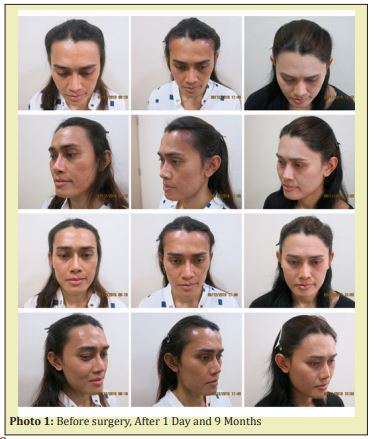
- 1. Prepare the donor site, occipital scalp, and pubic area with betadine solution and ethyl alcohol., Cut hair
- 2. Apply EMLA cream to anesthetize the donor rim and to help relieve the anxiety of the patient for 30 minutes
- 3. Ring block Local injection with 0.25% Xylocaine mixed with 0.125% Marcaine 40ml for the scalp.
- 4. 0.05% Xylocaine (1L NSS+50ml 1% xylocaine+ 1ml 1:1000 adrenalin) about 300ml for the pubic area. wait 10 minutes
- 5. Test for pain before the next step. Tumescent recipient area with Adrenalin solution 1; 200,000 20ml to increase tissue turgor and minimize bleeding during the operation
- 6. Compress the position of the new hairline with a Line Thai template. Compress mark to appear on the skin. Recipient site: Make slits by pre-cut surgical micro blade 0.7, 0.9mm to the bottom and parallel to skin crease. Follow the "Line Thai Micro Hairline" principle carefully. In this case, 1332 Slits is made for both bald areas
- 7. FUE By manual punch 1mm. From pubic area 405 FU. Scalp 927 FU. Keep all FU in Ringer lactate solution 4 degrees (ice cool)
- 1. Very small hair unit in the front 1,2 row
- 2. Bigger hair unit for 2,3,4 rows. (Never use 2,3 hair FU in the first 2cms of the hairline)
- 3. Pubic hair FU place very deep in the corner and between the existing hair. When inserting the hair follicle. Follow natural hair direction. Final check after all the placement was done. All the FU should look even to the skin
- 4. After rest for 20 minutes and no bleeding from the surgical site, then can send her home with instructions and pain medications Tylenol, Tramadol
No touch on surgical site. Sleeping with head upright. Etc.
Back to the office in 12hrs for a shampoo with a very mild shampoo. After dry, then apply mild antibiotic ointment on the recipient site for 2 weeks and donor site for 1 week.
Two weeks to three months at the Recipient site. Hair starts falling. This new hair, very loosely attached to the follicle, starts falling with an only slight touch. If an exam under the microscope will see dysmorphic hair (severely damaged hair). Hair Transplant is a cause of severe hair injury. Out of body completely, avascular, anoxia about 2-6hr before back to bath in body fluid again. This will terminate the growing cycle of hair and suddenly enter catagen. Catagen stage, dermal papilla because of anoxia start disintegrates, necrose, apoptotic, completely destroy in the perifollicular fibrovascular sac, stele. Hair Bulb, outer root sheath also deteriorates and replace by thickened basement membrane surrounding the club shape hair. In normal telogen, club hair will attach with the isthmus portion of the follicle very firmly. The lower part of the follicle all disintegrates. Only the isthmus, the permanent portion left intact and survived by anaerobic metabolism. Telogen follicle rests and waits for the next cycle. Catagen to telogen is accelerated, hair is damaged and loosely attached to the follicle. A small portion of newly grafted hair enters catagen and processes to telogen typically. Hair becomes club hair and rests in telogen until a new cycle start.1-8
months after surgery, about 70-80 % of hair will grow (Photo 2,3).
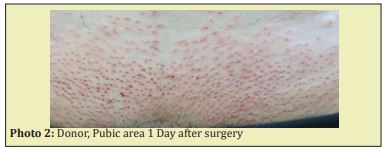
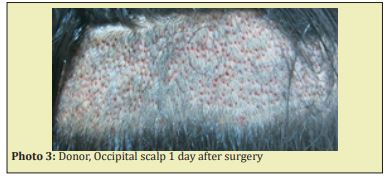
Line thai micro hairline
In Hair Transplant, constructing a natural soft, smooth hairline is the most important. I use the principle of Line Thai design to construct a hairline (Figure 2).
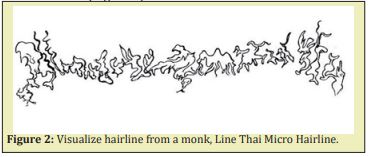
Line Thai is the way of drawing, design use in ancients Thai arts and crafts. Use in construction of buildings like houses, temples, palaces, etc.
First, I create a stainless-steel wire template. Many templates for the different hairlines (Photos 4-6). Copy from the hairline of Monk and Nun. Compress this template on the position of the new hairline. A compression line will appear on the skin. Make slits parallel to the skin crease and follow the compressed line Figure 3-5.
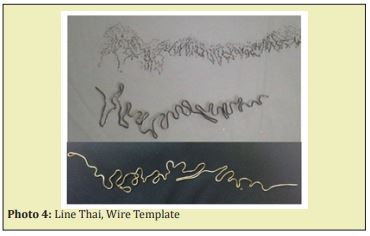
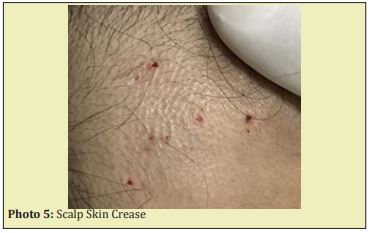
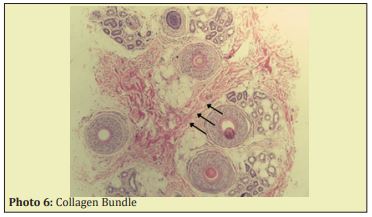
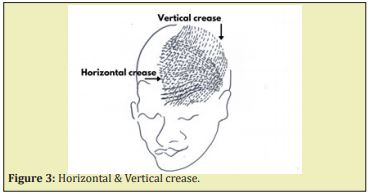
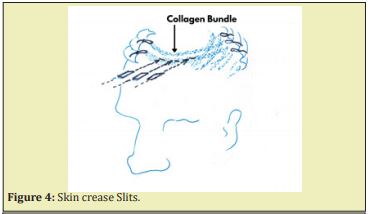
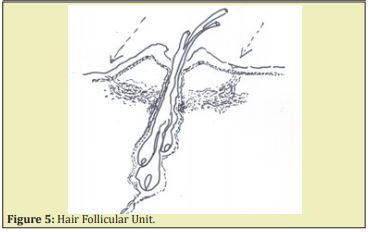
The bald area outside the hairline. Make slits parallel to skin crease and patterns like water flow or row of the wavy canal. Density about 33-55slits/cm2'.
Hair fiber is like violin strings. Has resonant property. Life hair is moving, vibrating, rubbing together all the time. To produce sound. Different sizes, lengths, positions, textures of hair produce different sounds. Pretend that you are the music composer. Compose this sound to a very melodic, pleasant music.
Assign music notes to the FU. Do, Re, Mi, Fa, Sol, La, si. Compose orchestra, light music, country music, melody, rhythm etc. Along the hairline. In the beginning, make slits follow the template. Later you add fine-tuning music slits. When the patient comes back 6-8 months for follow-up. Then you hear the music you composed.
During Placement of FU, pay attention to the angle of hair. One very small hair FU for the most front, one bigger hair FU, then 2,3 hair unit to follow. Create a slow gradient from the front toward the back.
Female hairline
Anatomy of Female hairline: The normal feminine hairline is the hairline that is the effect of normal oestrogen level in the blood circulation. Miniaturization from the front row gradually to the back is the hallmark of the hairline. Females have an outward convex curve shape of hair at both temples. With or without widow's peak at the mid frontal. Very soft-looking temporal peak. Very soft sideburn. Overall is a round or heart shape hairline.
Part line and part peak
Hair starts from the center of the whorl from the back of the scalp flow to the forehead. Divert into two portions, one to the left and one to the right. Produce part line and part peak. Hair flow on the scalp always has a diversion. A point of diversion sees from the front look like a triangle or radiation, a part peak, with the tip in the back point to the whorl. Compose with only single hair or vellus hair-an important landmark of the hairline. Suppose construction hairline without this part line, and part peak hairline will not look natural. The part line usually positions commonly at 1,2,3pm. Uncommonly at the midline. Naturally is 1 part line but an uncommonly double-part line (Figure 6).
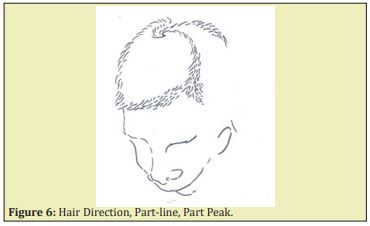
MID frontal
The 2nd most prominent part of the frontalis the mid frontal region. Mid frontal produces a straight, concave, convex, round or, oval shape hairline. Females have a more concave hairline. Widow’s peak is at this mid-frontal.
Temporal
Females have a more soft and smooth cover curvature at the temple. The shape of the hairline at the temple is S shape, or convex.
Temporal peak
Soft blunt point shape.
Sideburn
Compose of very small one hair curve forward or backward in front of the ear.
The direction of hair
Hair flow from the back of the scalp forward, downward and rightward commonly. Uncommon is upward hair or opposite hair.
Opposite hair
When the direction of hair goes against each other, will produce Opposite hair. The opposite and parallel will go against each other. Produce a diamond shape intersection. This intersection of opposite hair not only happens on the forehead but also on the chest wall, nape, forearm, etc. This diamond shape intersection is the cause of a variety of Widow's peaks and cowlick on the forehead Figure 7.
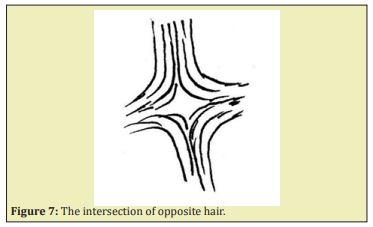
Widow's peak
Widow's Peak Type 1: A triangular shape group of hair at the middle of the forehead. The tip is round or pointed. Hair direction is downward and rightward. Hair direction is the same as scalp hair.
Widow's peak type 2: A group of triangular shape hair. Hair direction is straight upward. Hair flow from opposite hair. A tip is very point.
Widow's peak type 3: Type 1 and type 2 can combine in any proportion produce Type 3 (a portion of the intersection of opposite hair) (Figure 8, Photo 7).
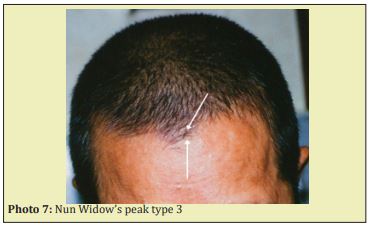
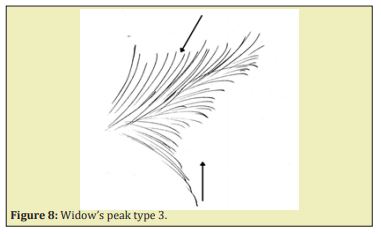
Significant of widow's peak
- 1. In the construction of female hairline for transgender. Generally, these ladies do not like to have widow's peak. They think widow’s peak is male, too strong and aggressive look. They prefer some things which are softer smooth and sweet look.
- 2. In lady who already has widow's peak. Do not try to eliminate it completely. Make it less strong and aggressive for type 1 widow's peak. It is possible to change the shape of the hairline from a triangle widow's peak to a smaller one or round because hair direction is the same both in the hair zone and in the peak zone. Type 2 has to match the hair direction (construct the same direction of the hair).
- 3. In the construction of a hairline for baldness. Widow's peak can give an illusion of a lower hairline. But still maintain the natural look.
- 4. Widow's peak is good for camouflage scar from previous surgery on forehead eg. coronal lift, scalp advancement, etc.
Widow's peak Type 2 is my first choice to camouflage scar from Juri’s Flap because of the same hair direction. Widow's peak will make this flap look much more natural.
F.U.E.
F.U.E. Follicular Unit Extraction: This is an advanced medical technique of removing hair follicular units from the permanent portion of occipital hair. Then transplant to the bald site. A surgical wound from the extraction site is healed by contraction, and filling the space with collagen can produce tiny white spots. (Photo 2,3) Easily cover under hair. Massage the scalp until it becomes very soft (about three months) before surgery. The spot can be smaller or no spot at all.
Donor
Occipital scalp, Beard, Pubic is a good source of donor’s hair. Because all these hairs are resistant to DHT(Dihydrotestosterone) will grow and stay after transplant. (Photo 2,3) Androgenic alopecia grade 5-7. Has limited occipital hair. Can get more donor hair from beard and pubic.
Hair follicular unit (FU)
Hair is growing from the hair follicle. Hair follicular unit (FU) can be. One hair FU, two hair FU, three hair FU, occasionally four hair FU. Each unit is about 0.5-1 mm far apart. The hair diameter is about 50-100 microns. FUE is the process of extracting these FU (Photos 8-10).
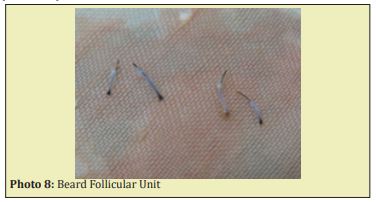
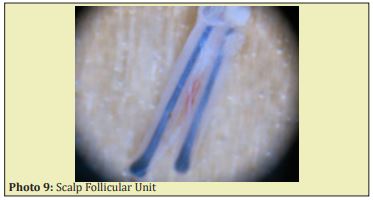
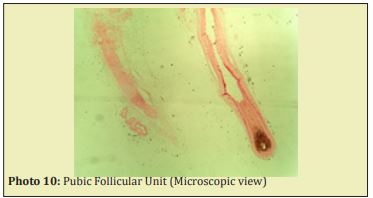
FUE technique
A small diameter punch 0.7-1.2 mm is most commonly use. The tip of the metal punch can be sharp or blunt. The inner diameter of the bevel can diverge or converge. The handle of the punch can be hand manipulate(manual) or Automate. Some doctor in Hair transplant uses a fully automated robot to harvest and implant the FU (Photo 11).9,10
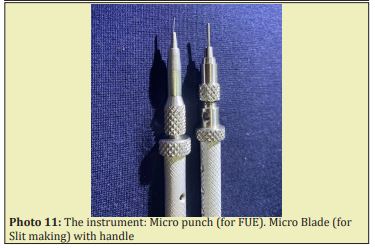
Extraction
Scoring of the epidermis, rotation around the axis of the hair follicle. Stretching the arrector pili muscle with the tip of the punch. To separate hair axis from the insertion of arrector pili muscle.
Torque rotation of punch. Cut the arrector pili muscle 2-3mm deep. Pull the punch out. Use any small forceps to pick up the unit gently. If anything attached to the end of the FU cut it do not pull hard and tear it. Perifollicular fibro-fatty-vascular tissue cup is the origin of the dermal papilla of the next cycle. FU is ready to plant to the bald site. Keep the FU in holding solution. My favourite holding solution is Ringer lactate.
Recipient site
The skin at the planting site should be of good quality. Free of any disease process. Generally, a young man with thick, tough soft, highly vascularised skin is a good candidate for High-density hair transplantation. In contrast, an old man with very thin, atrophic, hard, or scar skin is not good or even not a candidate for a hair transplant. Aim for low-density transplant.
Skin crease slits
The slit is a tiny surgical tear or split on the bald skin for insertion or planting of the Follicular unit (Photo 5, figure:2,3). The normal collagen bundle in the dermis is arranged almost parallel to the skin crease. Make slits parallel and through the bottom of the skin crease. This slit will split the cleavage plane of the collagen bundle. By slip the blade during making slit. The angle of this pocket will parallel to the axis of the original follicle also (Figure 3).
Slip through skin crease is through minimal tension line. Do not force. A very sharp and slippery blade (not the blade handle) will do the job. Create a pocket for the FU. By following, skin crease trauma is minimized, with less scar and blood loss (Photo 11).
Skin crease slit also makes it easy to make the incision very close for dense-pack high-density Transplant. Perpendicular (coronal), Parallel (sagittal) slits are artificial. The natural collagen bundle is never scientifically parallel or perpendicular. If used, these slits cause more trauma to the collagen bundle and produce more scarring and blood loss. The slit is done by a very thin and sharp microblade (photo 11). Cut to the size of FU. To minimized skin trauma and perfectly fit during insertion of the graft.
Hairline
Use the concept of Line Thai Micro Hairline for architectural and organization of slits to achieve a soft, smooth, natural look of hairline and hair pattern, maximal density per square centimetres, and enough blood supply to ensure the survival of the graft.
Density
FU density means the number of FUs per square centimetres. One slit can contain only one follicular unit, so the number of slits must be the same as the number of FU per square centimetres.
FU density is equal to slit density
22-33 FU/cm2=Low density
33-44FU/cm2=Medium density
44-55 FU/cm2=Dense pack.
Normal look 1 FU produce 2.5 hair (average)
Normal hair density is 66-77 FU or 160-190 hair/cm2.
In this year 2021. It is possible to achieve high density (dense pack) in 1 Session of 8-12hrs.
Indications for F.U.E
FUE can grow new hair, thicken, or new construction. In
- 1. Both men and women. Normal bald scalp, bald part, thin part
- 2. Eyebrow
- 3. Beard, moustache, sideburn, etc
- 4. Feminine hairline (for a bitemporal recession in female, for full feminization in transgender)
- 5. Scalp scar from surgery, trauma, facelift, etc
After a long road of preparation to become female. The lady needs male hormone reduction, either by surgery or by chemical. Female hormone replacement, Facial feminization, Breast enhancement, SRS (Surgical Reassignment Surgery), etc. The final touch is growing hair on the frontal and temporal scalp. To create a feminine or super feminine hairline to fulfil her dream. By F.U.E. from the scalp, beard, or pubic then transplant to the temple. In 6-8 months will convert to a more soft, smooth, round lovely lady face. A beautiful female. Her ultimate dream.
The author extends his most sincere thanks to Bernard Koire MD and William R. Rassman MD for their persistent mentorship in Cosmetic and Hair transplant surgery. The author further wishes to thank the patient for permitting the use of his photos for publication.
None.
The author has nothing to disclose.
- 1. Vong V. Normal hairline. Hair Transplant Forum Int. 1999;9:178.
- 2. Vong V. Whorl on Scalp of Thai monk and nun. Hair Transplant Forum Int. 2005;15(1):7
- 3. Vong V. Line Thai micro hairline. ISHRS 15th Annual Meeting; Las Vegas, NV. 2007.
- 4. Vong V. Line Thai micro hairline. Hair Transplant Forum Int. 2008;18(2):48.
- 5. Vong V. Beard hair transplant to the hairline. J Cosmet Med. 2017;1(1):63‒67.
- 6. James WD, Berger TG, Elston DM. Andrews’ diseases of the skin: clinical dermatology. 10thed. Philadephia, PA: Saunders Elsevier; 2006. 579 p.
- 7. Leonard CS, Shawn EC, Eleanor AK. Normal hair anatomy and architecture. An Atlas of Hair Pathology with Clinical Correlations; 2003. 5 p.
- 8. Elise A Olsen. Anagen Hair Loss. Disorders of Hair Growth, Diagnosis, and Treatment; 2003. 275 p.
- 9. Pascal Boudjema, William Rassman. Automation for FUE Graft Handling. Hair Transplant Forum Int. 2021;31:12.
- 10. Vong V. Eyebrow transplant. J Cosmet Med. 2020;4:46‒50.

